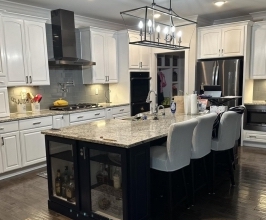Decorative Finishes- Distressing, Antique Finishes, Faux Marble and More
NOTE: Refer to the General Finishes brochures or the online design center regarding Wood Stains, Milk Paint, and Glaze Effects for basic information on the application of General Finishes water-based products and the preparation of the wood before starting.
Finishing furniture is an art form - you can create whatever you want. The terms "distressing" and "antiquing" are often used interchangeably in the wood finishing world. These techniques can be used separately or together along with glazing to obtain the degree of "aging" that you desire.
Distressing is a technique of marking the wood to give the character of generations of use. Start by gathering the essentials of character building; hammers, nails, screws, old hardware, literally anything you can pound into the wood that would leave an imprint. Then start hammering away. If it's been a long week and you need a lift, start a little character therapy project for yourself. Get rid of all that stress and finish a piece of furniture at the same time!
Antiquing is another form of distressing using sanding techniques, often followed by glazing to give the appearance of an antique piece of furniture that has been well taken care of over the years but, has slight natural wear and discoloration on the doors, edges, or sides. Walk into any furniture store and the trend toward using stains and finishes to create an antique look becomes abundantly clear. Corners and other recesses show the remains of an "old" finish while more exposed surfaces seem to have been "worn away" by time and use. This look of aging did not come from time but from a simple finishing technique that, with a little practice, you can master. Besides applying stains and topcoats, this process involves selective sanding of the "base stain" and wiping in of a "top stain," so it's best to use scrap wood get a hands-on feel for how the stains will look on the particular wood you're using. Here's how to do it all, step by step.
Glazing is the process of applying a translucent color to the surface, and then rubbing off the excess glaze to create many effects.
Distressed and Antique Finishes
For more design ideas using techniques of distressing and antiquing using Milk Paint, and Glaze Effects, click here.

- Two coats of Brick Red Milk Paint
- Water based topcoat to prevent color blending
- One coat of Basil Milk Paint sanded through
- Yellow Ochre Glaze
- Final top coats
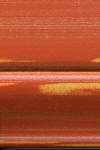
- Two coats of Autumn Haze Milk Paint sanded through
- Water based topcoat to prevent color blending
- Yellow Ochre Glaze
- Final top coats
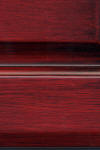
- Two coats of Brick Red Milk Paint
- Water based topcoat to prevent color blending
- Espresso Wood Stain
- Final top coats
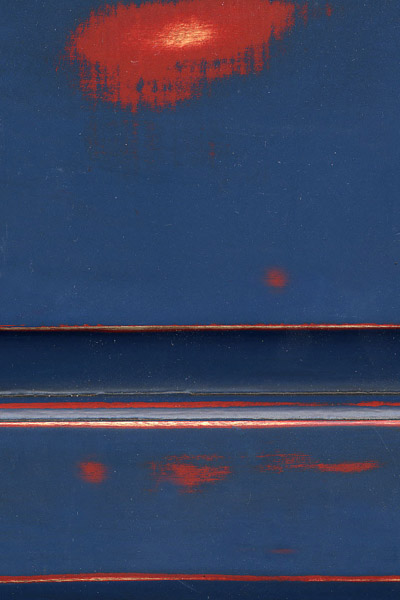
- Two coats of Red Pepper Milk Paint
- Water based topcoat to prevent color blending
- One coat of Federal Blue Milk Paint sanded through
- Yellow Ochre Glaze
- Final top coats
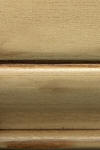
- Two coats of Millstone Milk Paint sanded through
- Water based topcoat to prevent color blending
- Van Dyke Brown Glaze
- Final top coats
Turn new furniture into heirlooms by creating a vintage, timeworn look. Antiquing is accomplished as follows: After applying your base color and letting it dry, sand the areas you want antiqued with a random orbital sander, following with 100 grit sandpaper by hand to enhance certain areas along the edges, around doorknobs, etc. The look you are trying to obtain is a slightly distressed piece, so don't hold the sander in one spot too long. DO NOT sand corners or moldings with a power sander - these areas should be done by hand. Do one side at a time. After you have finished a section, wipe it down with a slightly damp cloth to remove dust and reveal either the bare wood or under coat of finish beneath, creating the look of slightly worn areas. After you have sanded all surfaces inside and out with power sander (using either a #220 gray foam sanding pad or #400 grit sandpaper), you are ready to hand sand the edges, corners, and door. You will want to be thinking about where extra wear would be from using the doorknobs, etc. You will notice as you go along that different pressures will bring out more of the undercoat. The doors of furniture get the most wear, so open and close the door and take notice of where your hands are. Imagine over time how much the areas are used and touched. This should help you decide what areas need to be more distressed. Be careful not to sand too hard after you have wiped a section with the damp cloth. When the furniture is sanded while damp, too much paint will come off. It's important to gradually sand all areas.
Follow with Glazing if desired. The trick is to really slather it on (and we mean slather), keeping the surface wet as you apply the glaze. Then just wipe off the excess until you achieve the look you want. You could use an earth-tone glaze such as Van Dyke Brown applied to the sanded areas and moldings of a piece of furniture to create a discolored and aged look. Or you can use glazes to create soft layers of colors. Make the layers of color as intense as you want.
Finish with 3 coats of Waterbase PolyAcrylic following instructions in brochure.
Distressing with Milk Paints and Glaze Effects
Apply Glaze Effects over Milk Paints or any of the other waterbased products to achieve a distressed look. Choose furniture with some character such as raised panel doors or decorative molding - most pine pieces will work well. This is an excellent kitchen cabinet finish as well.
Begin with two coats of Milk Paint painted on for a base coat. Let dry for 2-4 hours and buff between coats with #400 grit paper or a super fine sanding pad. You have the option of painting a second color over the first, and sanding through to allow the first color to show through (color washing), or simply sanding though to the wood below.
Using coarse #100-#120 grit paper, sand all edges of raised panels, doors, drawers and corners of cabinet all the way through to bare wood. Sand heavily if you want a more rustic looking piece.
Liberally apply Glaze Effects (really get the surface wet) with foam brush or Handipainter pad over entire area. Wipe off excess with a lint free cloth to achieve desired look. The glaze will color your sanded areas and give the painted sections an aged look. Let dry 2-4 hours. Apply PolyAcrylic, High Performance topcoats for additional durability or increased sheen.
Creating Faux Marble
Note: These instructions are also included in the Water Base Finishing DVD.
Read the information on the application of General Finishes water based products and the preparation of the wood before starting. These instructions only address using General Finishes products to create special effects.
Creating a marble look on furniture is easy with Milk Paints or Wood Stains. The following are some useful tips to know before you begin. Marbleizing works best on closed grain woods such as pine, maple, birch, aspen, or alder. If you use "open-grain" woods, such as oak, the distinct, visible grain of these woods will show through the background of the marbleizing, and distort the look. Use your imagination! In nature, there are no two pieces of marble exactly alike. If you don't like the results simply paint over and start again.
List of Materials needed:
- Whitewash Wood Stain or Milk Paint Snow White
- Black Wood Stain or Milk Paint Lamp Black
- PolyAcrylic
- Natural sponge
- Lint free cloth
- Feather
- 220-400 grit sandpaper
- Foam brushes
- Apply 2 coats of White to get a solid background. Allow each coat to dry for 2 hours. Then lightly sand the surface to a smooth finish, following instructions in brochure.
- Dip the tip of the feather in Black and draw the marble veins on the surface in a diagonal direction. Use a slow, twisting motion with the feather as you drag the color across the surface. Veins should look like lightning bolts or tree branches, each vein roughly parallel to the one next to it. Avoid a crisscross pattern. Veins should continue from edge to edge. Allow the veins to dry for 5 minutes.
- Pour equal parts of White Milk Paint and PolyAcrylic in a flat pan. Dip the sponge in this mixture and then blot the excess on a paper towel. Sponge over the surface in a random pattern. Lift the sponge - do not drag it. The sponge will soften the veins and begin to cover some of the veins. Let this dry 5 minutes.
- Next, fold a cloth into a pad making sure there are no wrinkles on the bottom side. Wrinkles will leave an undesirable pattern on the surface. A latex handi-painter can also be used. Blot the entire surface by lifting the pad straight up and down. This will blend the black veins into the white creating a soft, subtle look.
- Use the feather again to lightly accentuate the veins using Black Wood Stain. Allow this to dry 2 hrs.
- Finish by applying 3 coats of Polyacrylic, sanding as instructed in the brochure.
Creating Primitive Wood Grain with Wood Stains and Milk Paints
Note: These instructions are also included in the Waterbase Finishing video.
Create the old world look of primitive grain on any piece of unfinished furniture. In this discussion, you can use Cranberry Red Wood Stain or Brick Red Milk Paint as the base color and Espresso Wood Stain or Pitch Black Glaze Effects as the secondary color.
- Apply 2 coats of the red base color, then sand the surface with #320 or finer grade sandpaper. Finish with a layer of Polyacrylic to prevent color blending. Allow each coat to dry for 2 hours.
- Apply a heavy coat of dark stain (such as Espresso Wood Stain or Pitch Black Glaze Effects) directly over the base color with a polyfoam brush or handipainter. Allow the stain to set for 5 minutes.
- Create a graining comb by beveling the end of a piece of corrugated cardboard with a razor knife. This will expose the ripples in the cardboard. Drag the comb across the stain to remove most of the top layer of color, allowing the base color to show through. The result will look like wood grain. You can purchase commercial graining combs from craft supply stores to create a different look.
- An option to Graining is Dry Brush Antiquing. Follow steps A and B. After the base color has dried, apply a thin coat of the Espresso or Pitch Black directly over the base color. Repeatedly brush the stain until it is almost dry to achieve soft grain lines. The wood stain softens the base color to a warm antiqued look.
- Finish with 3 coats of Waterbase PolyAcrylic as instructed in the brochure.
Pickling
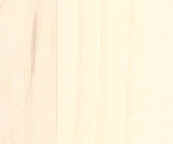 Pickling is simply applying a light color stain to wood; then wiping off the stain to let the color of the wood show through. The most popular pickle color is Whitewash Stain however you are not limited to white. Apply the stain and wipe off as much as you want while letting the wood grain show through the stain. The look you want to achieve is a soft subtle color. Let the piece dry and apply 3 coats of Waterbase PolyAcrylic following instructions in brochure.
Pickling is simply applying a light color stain to wood; then wiping off the stain to let the color of the wood show through. The most popular pickle color is Whitewash Stain however you are not limited to white. Apply the stain and wipe off as much as you want while letting the wood grain show through the stain. The look you want to achieve is a soft subtle color. Let the piece dry and apply 3 coats of Waterbase PolyAcrylic following instructions in brochure.
Another pickling method (the French provincial look) requires two stain coats. First apply a light color stain, such as Pecan Waterbase Wood Stain, and let dry for 2 hours. Then apply a coat of Waterbase PolyAcrylic and let dry for 2 hours. Finally, add the look of age by applying a wash coat of Whitewash. Push the White into the edges of raised panels or into detail areas such as carvings. Wipe off the stain from the other areas. Let the piece dry and apply 3 coats of Waterbase PolyAcrylic, following instructions in brochure.
Color Washing
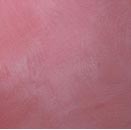 First, apply a base coat of Milk Paint. While the first color is still wet, immediately apply a second stain color over the base color. Then brush out the two colors using a dry bristle brush. This will blend the two colors to create a softer shade with interesting texture.
First, apply a base coat of Milk Paint. While the first color is still wet, immediately apply a second stain color over the base color. Then brush out the two colors using a dry bristle brush. This will blend the two colors to create a softer shade with interesting texture.

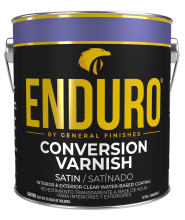 Enduro Water-Based Conversion Varnish
Enduro Water-Based Conversion Varnish
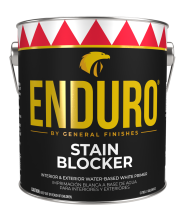 Enduro Water Based Stain Blocker Primer
Enduro Water Based Stain Blocker Primer
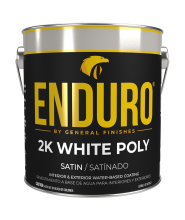 Enduro Water-Based Tintable 2K White Poly
Enduro Water-Based Tintable 2K White Poly
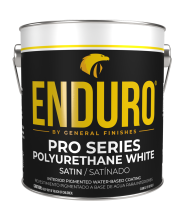 Enduro Water-Based Pro Series White Polyurethane
Enduro Water-Based Pro Series White Polyurethane
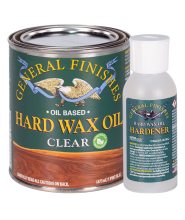 Hard Wax Oil & Hardener
Hard Wax Oil & Hardener
 Gel Stains
Gel Stains
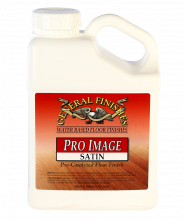 Pro Image Flooring Topcoat
Pro Image Flooring Topcoat
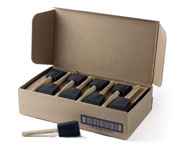 Jen Poly Brushes
Jen Poly Brushes
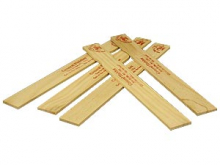 Stir Stix
Stir Stix
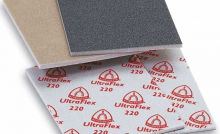 Ultraflex Softback Sanding Sponge
Ultraflex Softback Sanding Sponge




